In the 1960s the U.S. Navy started a program called TACAMO with a very important mission. It had to provide a survivable relay link with the fleet of ballistic submarines. Soon, the Soviet Union started its own effort that culminated in the Tu-142MR “Oryol” (Bear-j).
Today, we will visit the Tu-142MR little known history. Let’s dive right in.

The Nuclear Triad
The strategic nuclear triad has been the basis of the U.S. nuclear deterrent since the 1960s. It consists of:
- long-range heavy bombers,
- intercontinental ballistic missiles (ICBMs),
- and submarine-launched ballistic missiles (SLBMs).
Among them, the ballistic missile submarine’s (SSBN) leg was the most expensive. However, its sea basing and silent patrolling capacities help it stood out. Thanks to these features, it became one of the most durable parts of the U.S. nuclear arsenal.

Likewise, the cost per RV (reentry vehicle) for the SSBN was the lowest of the three. But, being the most cost-effective option does not remove its flaws. As such, since it relays on submarines, it is prone to have communication issues.
In fact, communications with SSBN forces at sea were the most tenuous among C3 carriers. This could result in delayed orders or launch coordinates. Something problematic in a nuclear exchange that could hinder retaliatory nuclear launches.
Let see this in more detail…
The Submarine communication problem
During World War II, Submarines used HF, VHF and UHF radio bands for communications. Within line-of-sight, VHF/UHF was used. And, when the boat was very far from the shore station, HF was used.
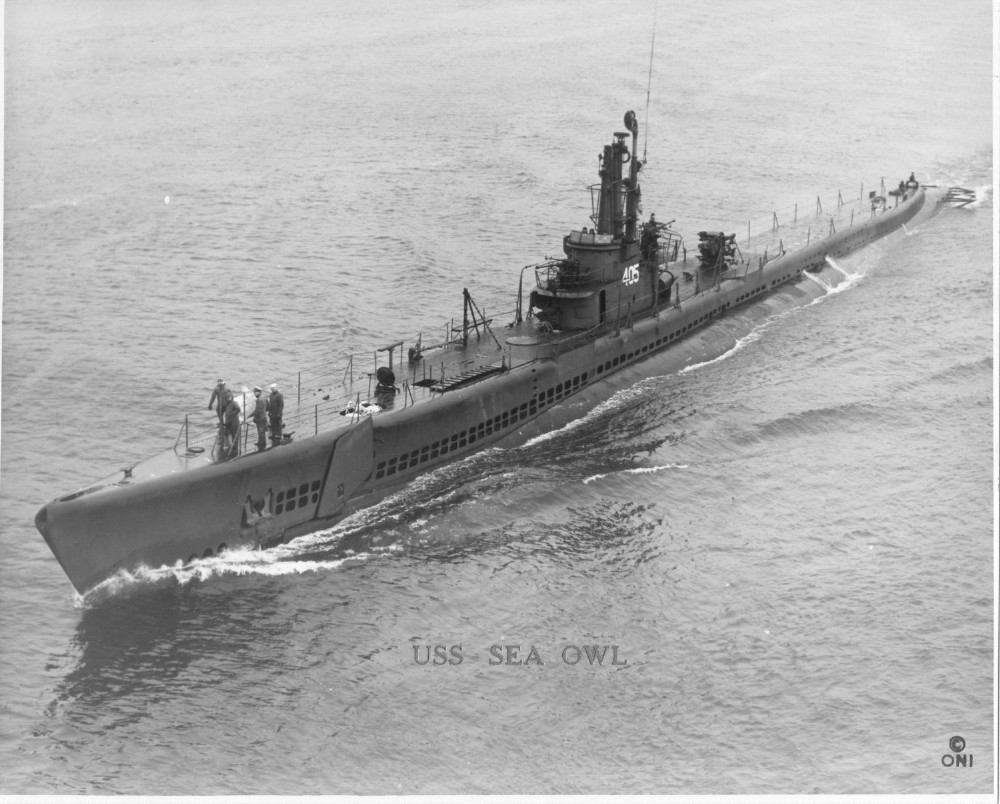
But, these radio frequencies have a problem. They can not penetrate seawater. So, the submarine had to come to periscope depth and raise an antenna.
In the 1950s, both the United States and the Soviet Union started development of ballistic-missile submarines. In the case of the United States, such a program was the Polaris weapons system.
The first Polaris-type submarine was the USS George Washington and she was commissioned on December 30, 1959. The Navy had sought to develop a weapon system that would allow it to have a role in America’s nuclear deterrence mission.
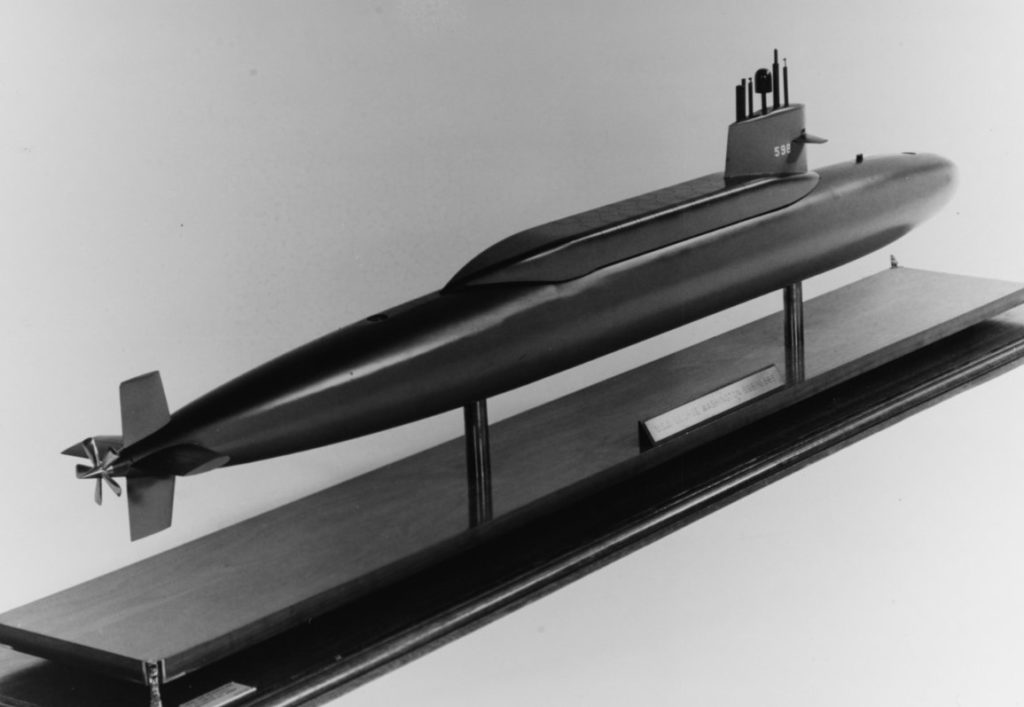
But, a submarine deterrent force needed:
- uninterrupted reception of communications
- quick reaction to command messages
- remaining undetected
But how?
A Very Long Wave
By bringing the very long wave (VLF) technology abandoned since the 1920s. VLF radio waves are in the range of 3 to 30 kilohertz (kHz) and wavelengths from 62 to 6.2 miles long.
Radio signals at this wavelength can penetrate seawater, propagate great distances with small attenuation and are highly reliable. Before the First World War, VLF offered the only way for round-the-world communications.
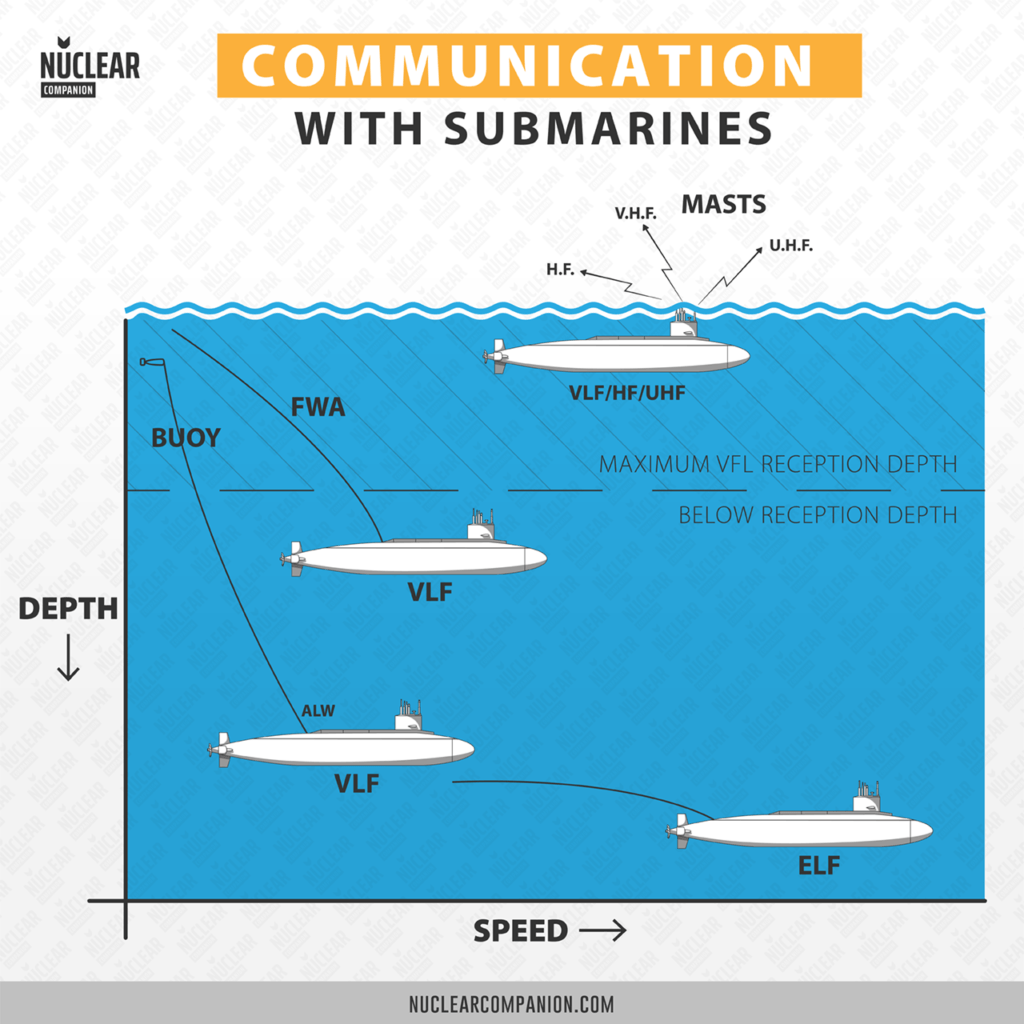
Downside? Poor bandwidth and it can only penetrate seawater a few tens of feet.
For that reason, the submarine had to deploy a floating wire antenna (FWA) or a communications buoy. These would reach reception depth and allow receiving messages. But, they imposed a restriction on the speed and depth at which the submarine can operate.
But, also there another issue here. Given the scale of its wavelengths, VLF requires gigantic antenna arrays and the use of very high power.
In 1958, the U.S. Navy started the construction of a new VLF station at Cutler, Maine. The station, that occupies 2,000 acres on a peninsula and has 26 towers (850 to 1000 ft.high), cost $63 million.
In the 1960s and 1970s, the primary VLF stations for American SSBNs were:
- North West Cape in Western Australia, which covered the southern Pacific Ocean
- Jim Creek in Washington, which covered the northern Pacific Ocean
- Cutler in Maine, which covered the Atlantic Ocean
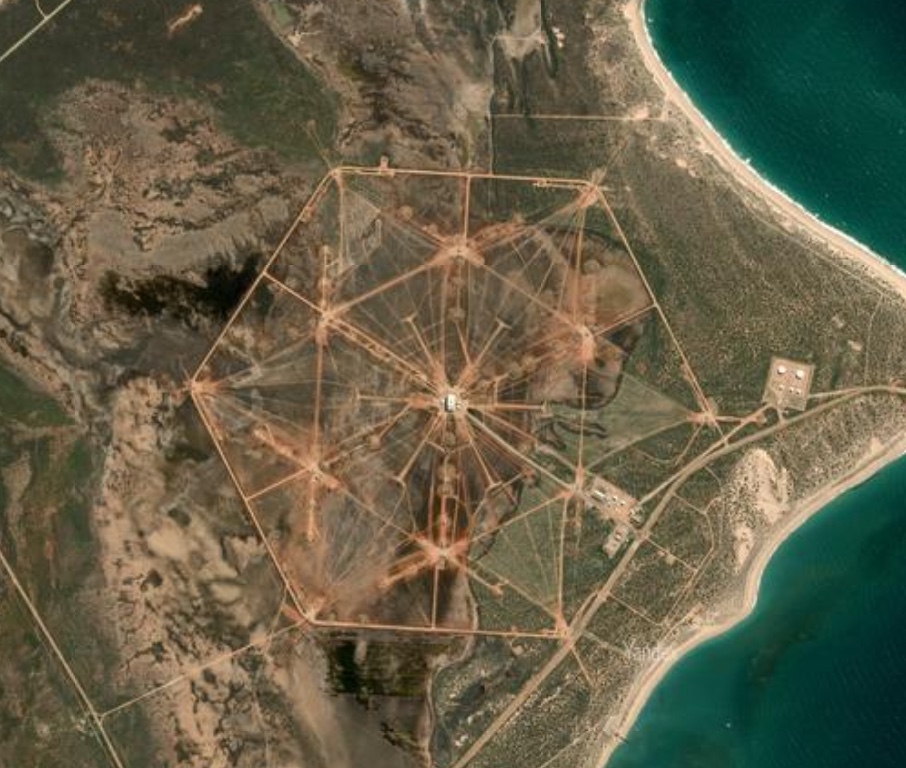
But, these big stations were not survivable. Indeed, they were highly vulnerable soft targets and a prime nuclear objective at the outset of hostilities.
Again, the U.S. Navy had a solution: TACAMO.
TACAMO or Take Charge And Move Out
TACAMO is an acronym derived from the old marine challenge to “Take Charge And Move Out. It is the name given to a fleet of flying broadcasting stations.
Yes, aircrafts equipped with VLF emitters did the trick. Unlike shore stations, TACAMO is survivable in a nuclear strike.
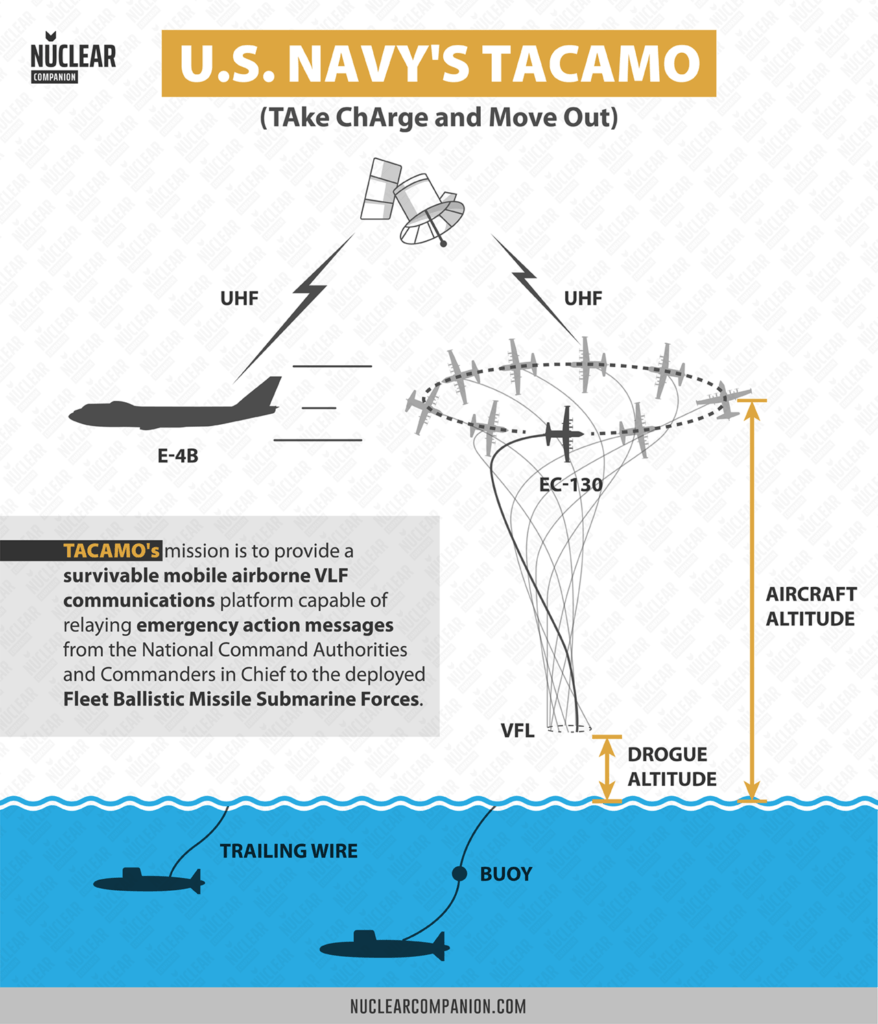
TACAMO launched in the early 1960s. And for the job, the Navy selected the C-130 which trailed a long VLF antenna and flew in circles.
It started first as a 25-kilowatt VLF transmitter and a single 30,000 trailing wire antenna. And it evolved into a 200-Kilowatt transmitter with dual trailing wire antennas.
In 1968, The U.S. Navy established two squadrons of these aircraft, one based in the Atlantic, and the other in the Pacific. Between these two squadrons, there was at least one aircraft flying at any given time.
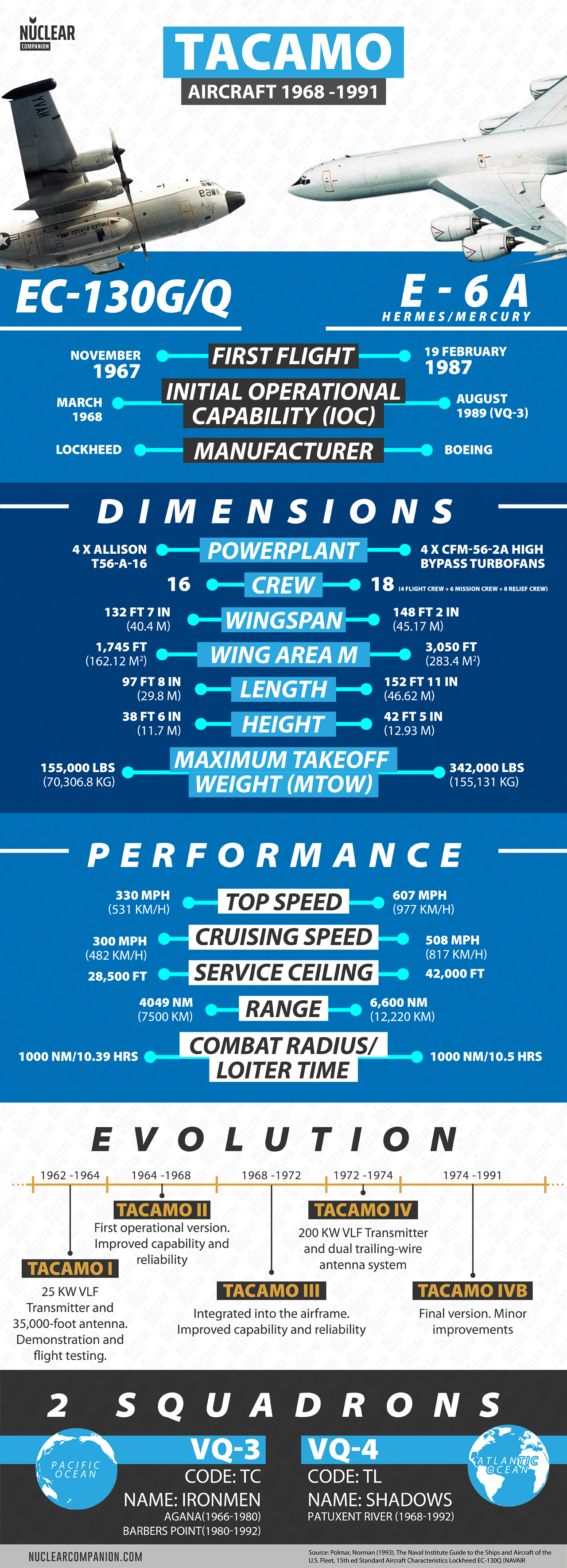
The EC-130G/Q, the primary aircraft in the TACAMO program was later replaced by the E-6 Mercury. This new aircraft was based on the Boeing 707-320, entering naval service in 1989.
Meanwhile, the Soviet Union was also busy working in a submarine comparable to the American Polaris system. It was the Project 667A (NATO-designated Yankee). The first submarine of the class, K-137, was commissioned in 1967.
Soon, the Soviet Union would start its own TACAMO program.
The Soviet Response: The Tu-142MR
On October 3, 1972, the Council of Ministers of the U.S.S.R. released a resolution requiring the Beriev design bureau to design and build a submarine communications relay aircraft.
This aircraft would have to be able to process communications from naval units and command posts and relay them, at any given time, to submerged forces. Most of all, to those nuclear missile submarines deployed throughout the world’s oceans.
This new special mission aircraft would not be an entirely new design. Instead, it would be based on the Tupolev Tu-142MK airframe being built in Taganrog.
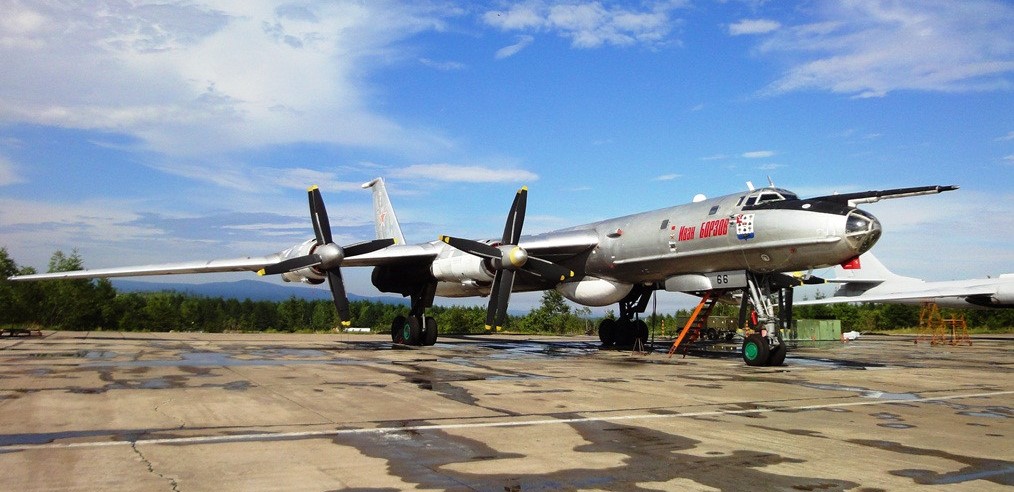
There were slight differences between the two aircraft which led to the addition of the “R”. The “R” stands for retranslyater, which translates as “communications relay aircraft.”
In 1973, under the codename “Eagle”, leading the project were S. A. Atayats as Deputy Chief Designer and A.P. Shinkarenko as the leading designer.
Beriev Design Bureau (OKB-49)
The Beriev design bureau, based at Taganrog, had long specialized in flying boat designs. And it was the main supplier of marine aircraft to the Soviet navy. Since 1968, its chief designer was Aleksey K. Konstantinov.
This was the first time that the USSR began developing this kind of aircraft technology. Therefore, technical problems arose shortly.
Developing and testing the aerial
One of those difficulties was the design and production of the long-distance cable antenna. Needing it to be able to handle the air stream, a cable of such length was a whole new challenge for Soviet designers. It also had to be strong enough for keeping the antenna stable in the air during all the process of its release, as well as during its cleaning and towing.
In 1974 took place the testing. The chosen plane for the task was the four-turboprop An-12 – the Soviet counterpart to the Lockheed C-130 Hercules.
The testbed An-12 was c/n 9900902, formerly “19 red”. A 2500m (8,200-ft) long trailing wire aerial (TWA) prototype was attached to it along with a mighty BLT-5 winch driven by a ram air turbine.
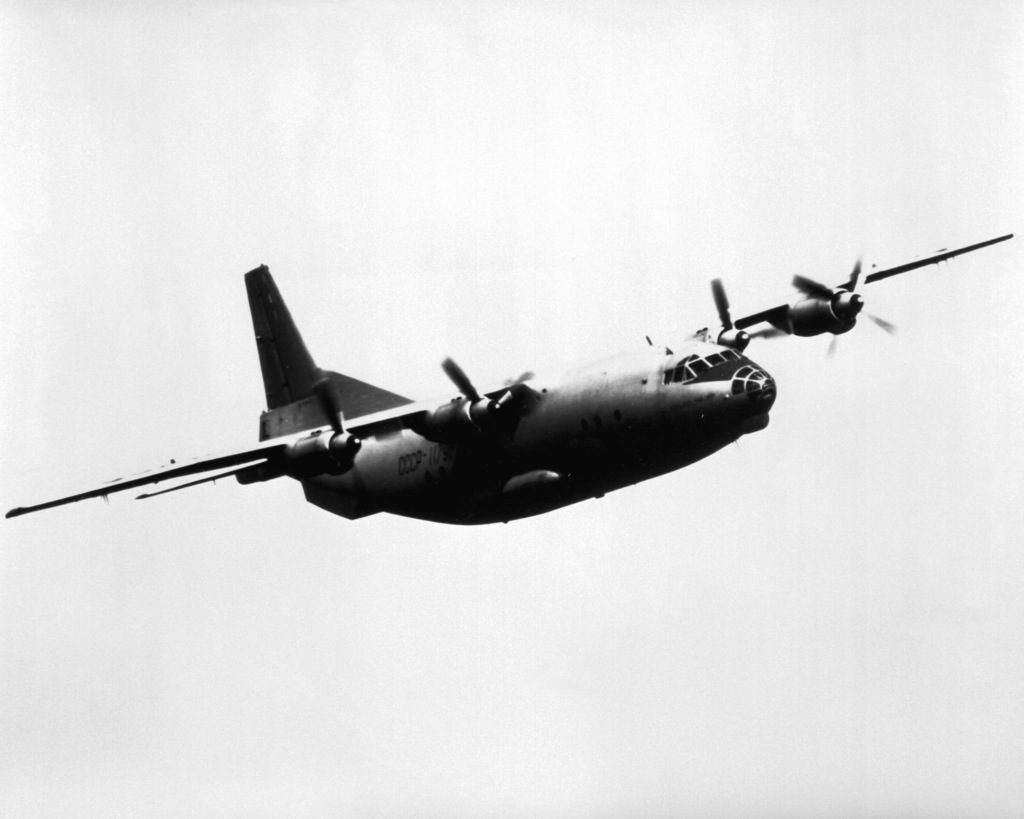
The aircraft could be recognized by its three cigar-shaped fairings at the wingtips and atop de fin. Also, its aerials, a lot of them, leaded observers to believe the aircraft was an An-12VKP Zebra Airborne Command Post.
Several tests were required for making functional the whole communication system, though. During this time, many tests presented failures of all sorts.
The Tu-142MR prototype
In March 1977, the Tu-142MR prototype was built at the Taganrog factory (TMZD) by converting a Tu-142MK manufactured in 1976 (c/n 8058014301002).
The plane had the usual glazed nose. It also had a deep chin similar to the early Tu-142 (izdeliye VP) “centipede.”
This chin was designed to hold the Groza-134VR (thunderstorm) weather radar. Yet, in the production model, this system was set inside a large thimble radome flanked by ECM antenna blisters.

This allowed for a more shallow chin, eventually deemed to house the Sayany-RT ESM system. Additionally, the nose glazing was replaced in the production model.
Also, there were missile warning system antennas mounted beneath the tail gunner’s station. These additional warnings were also present in the Tu-95 MS.
One of the early problems was the carrier aircraft’s lack of electric power. Its power capacity couldn’t handle the new electronic components for it. To deal with this concern, the engineers added three turbo-generators to the aircraft.
In July 1977, the prototype made its maiden flight from Taganrog-Yoozhnyy airfield captained by test pilot E.A. Lakhmostov.
Joint state tests of the aircraft continued until December 1980. Tests were held in Taganrog, Feodosiya and Kipelovo AB.
In the end, after the Tu-142MR entered service the prototype was also put into use. Its first deployment was to the Pacific Fleet, where it was dubbed “27 Red.” Then, when making part of the North Fleet, it became “11 Black.”
Service and Deployment
The Soviet Naval Aviation (AVMF) introduced the TU-142MR in 1985. The type saw service with two of the Soviet Navy’s four fleets, the Northern Fleet, and the Pacific Fleet.
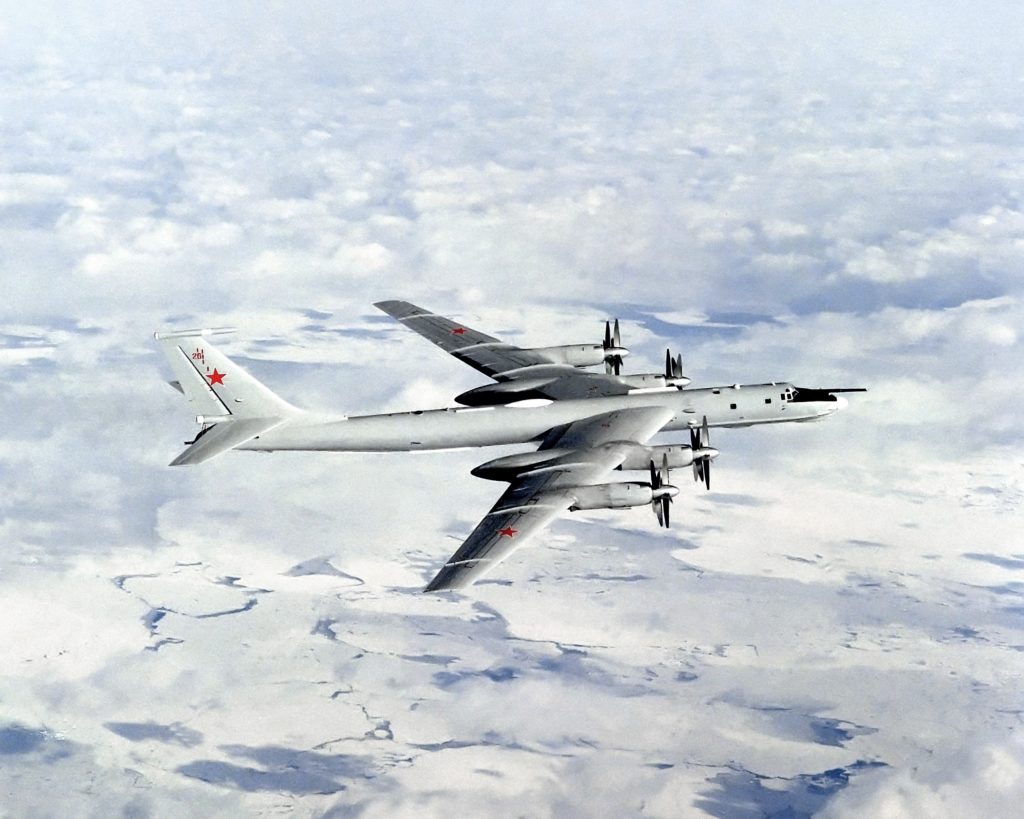
The naval units to operate the Tu-142MR were:
- The third AE (Aviaeskadril’ya) from the 76th Long-Range Anti-Submarine Aviation Regiment (76th OPLAP DD) of the Northern Fleet in Kipelovo AB.
- The first AE (Aviaeskadril’ya) from the 310th independent Long-Range Anti-Submarine Aviation Regiment (310th OPLAP DD) of the Pacific Fleet in Mongokhto.
The first two aircraft arrived in Kipelovo on 1 August 1985. There, the Soviet Navy established a special attachment and testing started as soon as January 1986. Three crew captained by Maj. S. S. Kichigin, Maj. I. P. Serebryakov, and A. V. Pryanikov participated in it.
Then, on June 1986 the detachment became operation as part of the 3rd communications-relay AE ( Aviaeskadril’ya).
The existence of the Tu-142MR was known and acknowledged in the western world by 1986. Although its specific purposes were unclear at first, it was soon enough acknowledged. NATO designated it as “Bear-J”.
By the end of 1992, each of these squadrons consisted of six or seven Tu-142MR aircraft.
In 2002, the 310th OPLAP DD merged into the 568th Guards Independent Naval Composite Air Regiment (568th GvOMSAP).

The TACAMO mission
The plane’s VLF antenna was the main equipment for the TACAMO mission. It was connected to a powerful transmitter aboard the plane and it broadcasted messages to submarines that could travel thousands of miles.
Also, it imposed a considerable physical strain on the plane and the pilots.
Signal range and seawater penetration were determined by the antenna verticality. Achieving proper vertically using a long antenna while moving was not easy.
When the aircraft was either transmitting or receiving messages at VLF, it had to fly in a gradual circle with the aerial near the water. That meant an altitude between 24,600 and 29,530 ft (7,500-9000 m).
Additionally, extending the aerial and the airflow increased drag considerably.
On average, the extended aerial generated a weight of 135.8 tons (138 tonnes) and increased fuel consumption significantly (reaching 5.3 kg/km, or 18.8 lb/mile).
Above 157.5 tons or 160 tonnes, the aircraft had to operate very close to the stall and the angles of attack were close to critical.
Also, if the antenna started to whiplash, it could pull itself loose or force the crew to cut it. Air turbulence was one of the most common causes of loss of the antenna. And, no spare was carried on the aircraft.
Tu-142MR mission performance
According to Steven J. Zaloga, in his book The Kremlin’s Nuclear Sword, Russian accounts suggested that the Tu-142MR had parameters inferior to those of the U.S. TACAMO.
Pre-launch vulnerability
We can expect that the TU-142MR airbases would be the first targets in a nuclear war. Indeed, aircraft on the ground are very vulnerable to a surprise attack. That is why the U.S. kept a Tacamo aircraft always airborne.
U.S. submarine missiles launched against Tu-142MR aircraft on day-to-day alert could catch them on the ground or immediately after takeoff. For that to happen, the flight time of the attacking missiles needs to be shorter than the reaction time of the aircraft.
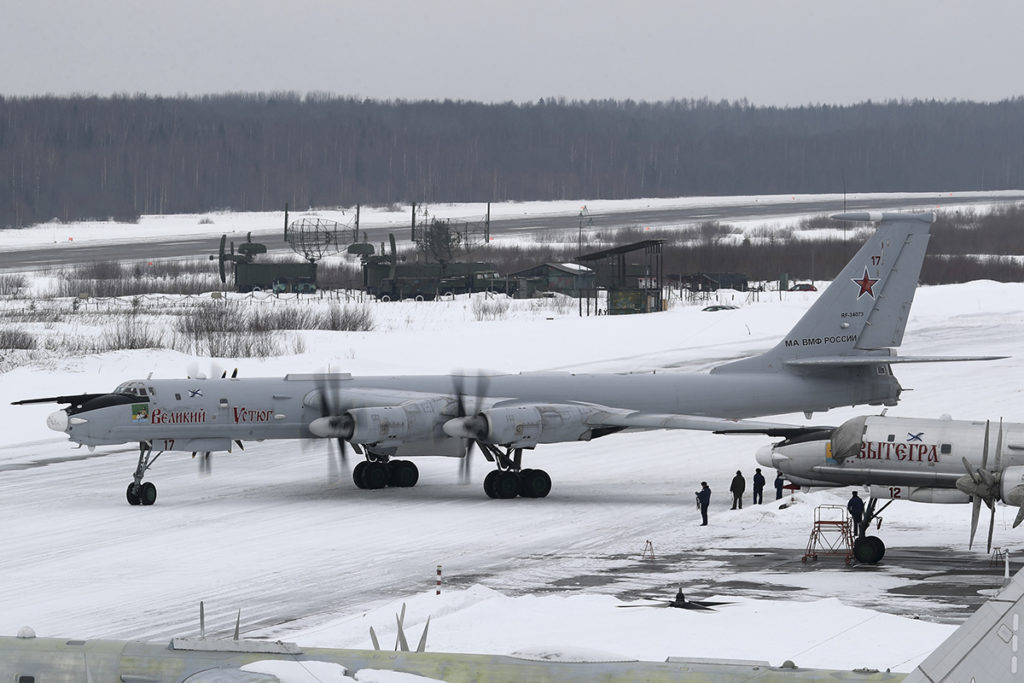
A U.S. missile fired from the Baltic Sea, the Norwegian Sea or the Barents Sea could reach Kipelovo AB in 15 minutes or less. In the case of Mongokhto AB we could expect similar o shorter times.
For an aircraft to take off at least we need to:
- Crew scramble
- Engine start-up
- Taxi
- Others procedures preceding take off
But even if the aircraft takes off, we have to consider the lethal radius of the nuclear explosion. For example, a 1 Megaton explosion has a 42,000 feet (12.8 km) lethal radius from the Aimpoint for an aircraft hardness of two psi of blast pressure.
To summarize, unless the Tu-142MRs were already airborne or positioned at the end of the runway with engines running, they should have been lost to a U.S. surprise attack. Also, we don’t know any public information regarding the alert readiness of the Tu-142MR.
The Tu-142MR in Detail
The Tu-142MR was an all-metal monoplane with a swept wing, conventional tail surfaces, four turboprop engines, and retractable tricycle landing gear.
The typical crew consisted of nine members: two pilots, a navigator, a gunner, and four mission equipment operators.
Some elements of the Tu-142MR stayed true to its original base model: the late Tu-142M. However, others differed in significant ways.
The rear fuselage and tail design largely stayed intact. Only the tailfin and leading-edge received minor modifications. Designers needed to make room for a necessary antenna.
However, the nose was now unglazed. It was also upgraded with a pimple radome, a refueling probe, chin sensors, and a cable duct.
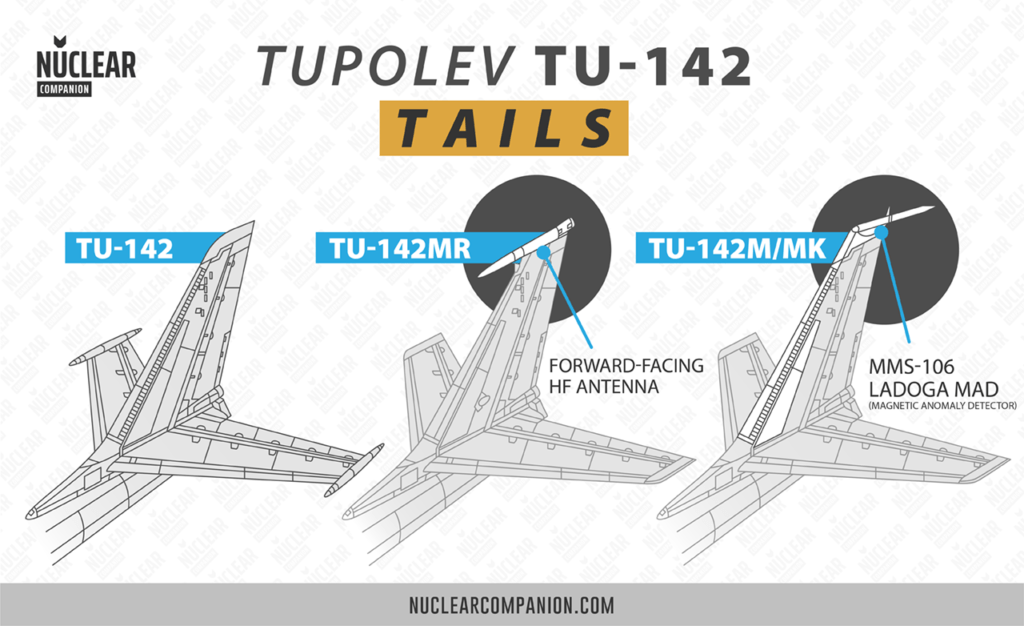
Additionally, the extended fin received a forward-facing HF probe antenna. This antenna concluded at the rear by another circular spiral passive receiver antenna.
The TWA
The Tu-142MR also differed in having a large ventral canoe fairing instead of its search radar. The canoe, powered by a ram-air turbine, held the trailing wire aerial (TWA) drum. The TWA was a 7,680 meter (29,200 foot) long zinc-plated steel cable with a thickness of 7.5-mm (19/64 in).
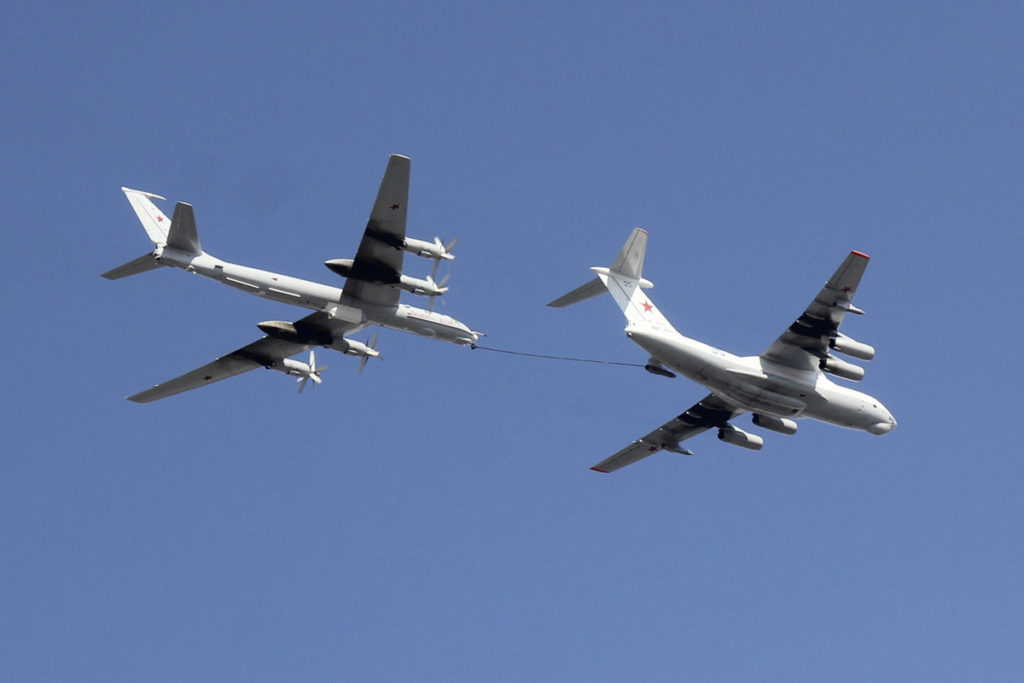
The TWA counted with a stabilizing drogue parachute. It helped the TWA to maintain control during the lowering process. Also, it took it 37 minutes to deploy fully and could be entirely re-wound in a total of 48 minutes.
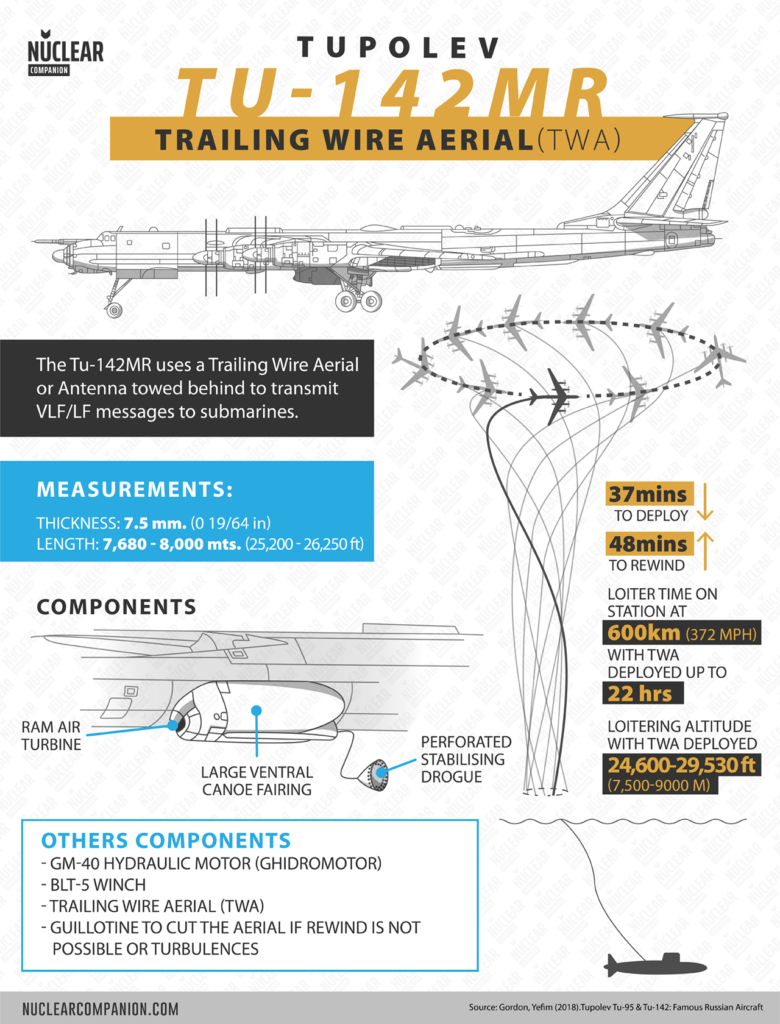
To deploy this parachute, the aircraft would fly in small orbits while lowering the cable, as a weight at the end helped to keep it nearly vertical. Yet, the extension of the external unit and the air intake during this process increased the drag on the aircraft
Also, the cable was susceptible to jamming after performing a certain number of circles. This was primarily due to backspin and the accumulation of twists.
Powerplant
The Tu-142MR was powered by four Kuznetsov NK-12MP turboprop engines. With each engine rated at 15,000 shp, these are the most powerful turboprop engines in service.
In a turbojet engine, high-pressure exhaust gases provide jet thrust. But, this was not the case. Two-thirds of the turbine power was used for driving the engine compressor and accessories. But, the other third was transmitted to huge contra-rotating propellers through a reduction gear.
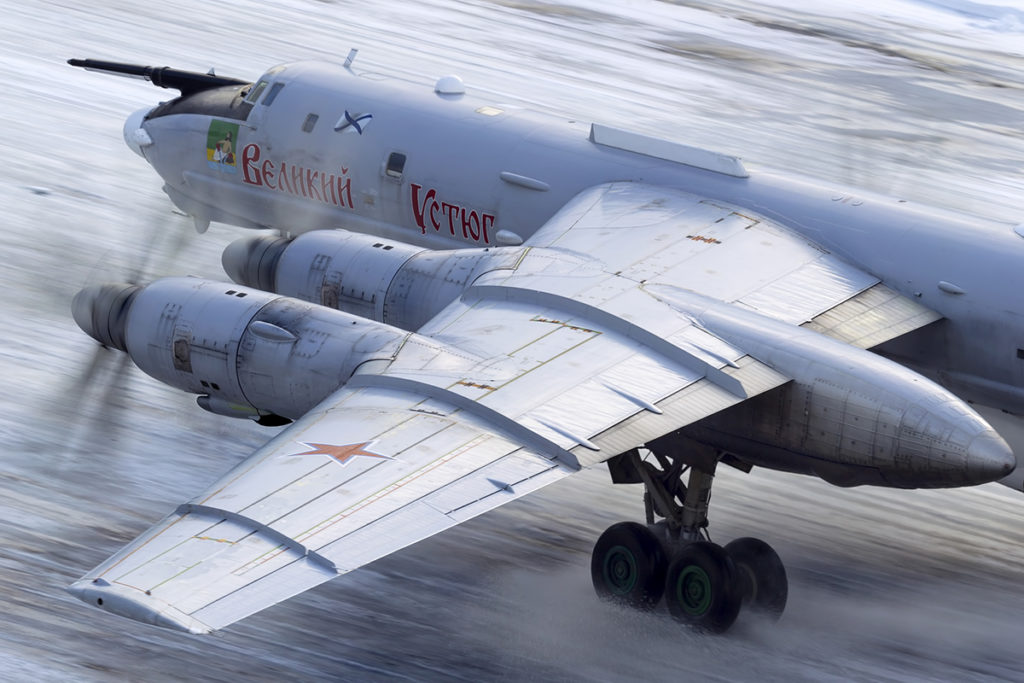
This was not a new design. The Kuybyshev Design Bureau(OKB-276, now JSC Kuznetsov) designed the NK-12 in the 1950s under the leadership of N. D. Kuznetsov in Kuybyshev(now Samara).
The NK-12MP was a forward step in the NK-12’s evolution being its predecessor the NK-12MV. It features a new constant-speed drive (CSD, postoyannykh oborotov), a more powerful AC generator and improved reliability.
One critical component was the contra-rotating AV-60K propeller each engine has. These massive propellers have a direct impact on every aspect of the Tu-142MR´s performance.

Each of these units consisted of two massive four-bladed propellers. The front propeller (2775-06KU) rotated in the opposite direction than the rear propeller (278B-06KU). This improved the efficiency of the propellers using the engine’s power.
Also, all blades were featherable and made of Aluminum alloy. In addition, the pitch angle was configured by the pilot.
It was the Stupino Design Bureau (OKB-120, now NPP Aerosila) in Stupino which designed these propellers. Aerosila was the Soviet Union’s leading authority on propellers and auxiliary power units. On the other hand, it was the Stupino Machine-Building Plant (Plant 120) which manufactured them.
Navigation
Instead of the Korshun search radar of the Tu-142MK, the Tu-142MR mounted a Groza-134VR navigation and weather radar. This radar was capable of detecting large land targets up to 140 km (87 miles) and weather features up to 250 km (155 miles).
The positioning of this system switched from the chin to a large thimble radome in the nose of the aircraft. But, the Groza-134VR radome was mounted in either the nose or the belly. Its location depended on the presence of the Sayany-RT EW suite.
All its components, except for the antennas, were in a pressurized compartment.
The Tu-142MK scanned the sea surface hunting for submarines using the Korshun radar. But, the Groza-134VR pulse radar main purpose was to detect radar activity and carry out surface surveillance. Its system has a horizontally-searching aerial and an azimuth-to-range indicator.
Communication Equipment
Communication with submarines was the primary purpose of the Tu-142MR. For fulfilling its duty, it was fitted with Oryol (“Eagle”) mission equipment.
The Radio Communications Research and Development Institute, based in Gorkiy, designed it. This equipment was well-associated with the aircraft, which received “Oryol” as its nickname.
The communications equipment consisted of :
- Two HF radios
- Two VHF (very high frequency) radios
- Two UHF (ultra-high frequency) radios
- A VHF radio transmitter
- Two sets of VLF receivers
- Seven HF receivers
The power supply, Etyud relay equipment, transmitters, and receivers were reported as housed in the forward weapons bay of the marine warfare Tu-142 variants.
There were several communications antennas located on the Tu-142MR. Many of them occupied a distinctive, forward-facing spike atop the fin, while others were at the dorsal portion of the aircraft. These last antennas consisted of the traditional HF rails, as well as a Satcom dome and a large Glonass satellite navigation blister.
Additionally, there was a dielectric teardrop fairing over a satellite communications antenna. It was located just aft of the trailing edge of the wing.

The crew’s cabin was VLF-proof or electromagnetic radiation protected. This was done using 1-mm thick steel wire mesh and special coating. The windows have detachable frames of wire mesh.
Defensive Systems
The Tu-142MR had a basic system of defense. This aircraft was meant primarily for relaying messages. Engaging the enemy was far from the ideal situation.
It had, nonetheless, its weaponry. First of all, it was the Sayany-RT ECM/ESM defensive system, consisting of active jammers and chaff/flare dispensers. It was named after a mountain range in southern Siberia.
Likewise, the aircraft had a UKU-9K-502 tail barbette. Mounted on it were two Gryazev/ Shipunov GSh-23 twin-barrel cannons.
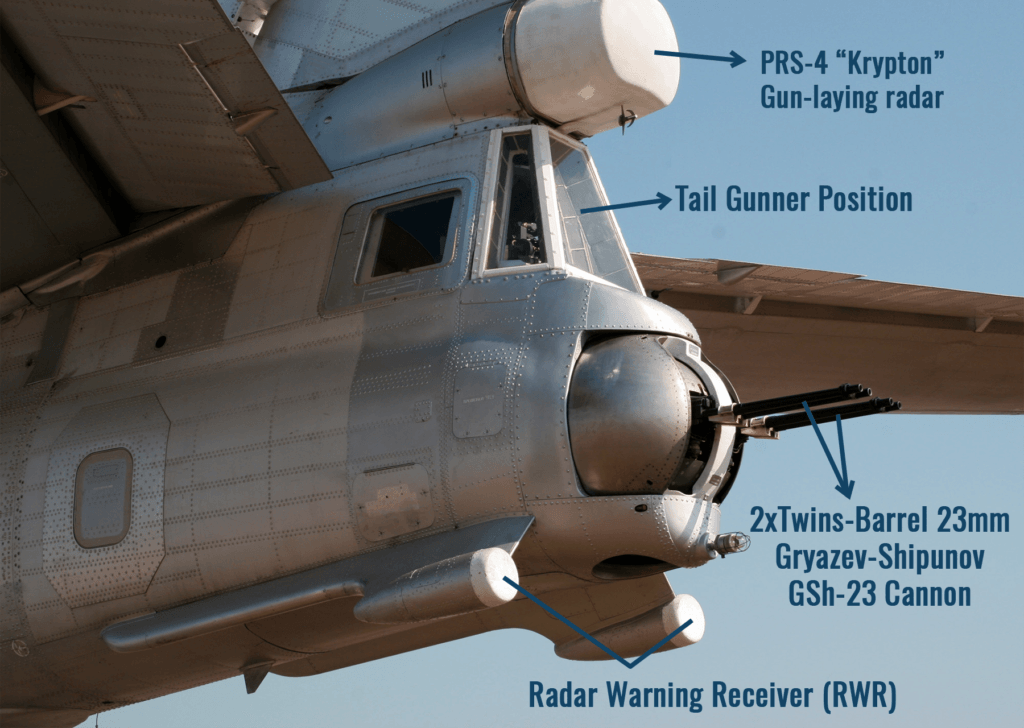
The GSh-23 was designed by V. P. Gryazev and A. G. Shipoonov at KBP (Konstrooktorskoye byuro priborostroyeniya – Instrument Engineering Design Bureau). KBP, located at the famous Tula Weapons Factory, was known until 1966 as TsKB-14.

Operating these cannons was one gunner who aimed them using the help of:
- A PS-153K sighting station (pritsel’naya stahntsiya, kormovaya – rear)
- A PRS-4 Krypton gun ranging radar with an acquisition range of some 4 km (2.5 miles). It was designed by OKB-373 (TsKB Avtomatika) and produced in Plant-373 (currently PJSC Saturn) in Omsk.
- A AVS-153 ballistic computer (avtomaht vozdooshnoy strelbyy – automatic air-to-air gunnery device)
- A ADP-153 automatic parallax compensator (avtomaht dopolnitelnovo parallaksa)
Typically left alone in the tail barbette, these operators were rather isolated. The rest of the crew spent most of their time in the cockpit or main portion of the aircraft in their various duties.
Selected Bibliography
- Tupolev Bombers, David Donald
- The Button: The Pentagon’s Strategic Command and Control System, Daniel Ford
- 75 years of Beriev Aircraft Company, A.N. Zablotsky, A.I. Salnikov
- Antonov An-12: The Soviet Hercules, Yefim Gordon, Dmitriy Komissarov
- Tupolev Tu-95 & Tu-142: Famous Russian Aircraft, Yefim Gordon, Dmitriy Komissarov
- Soviet and Russian Testbed Aircraft, Yefim Gordon, Dmitriy Komissarov
- Soviet Naval Aviation 1946-1991, Yefim Gordon, Dmitriy Komissarov
- The Kremlin’s Nuclear Sword, Steven J. Zaloga
Conclusion
I hope you enjoyed Tu-142MR story.
Now I’d like to hear what you have to say.
Or maybe you have a question about something you read.
Either way, go ahead and leave a quick comment below right now.
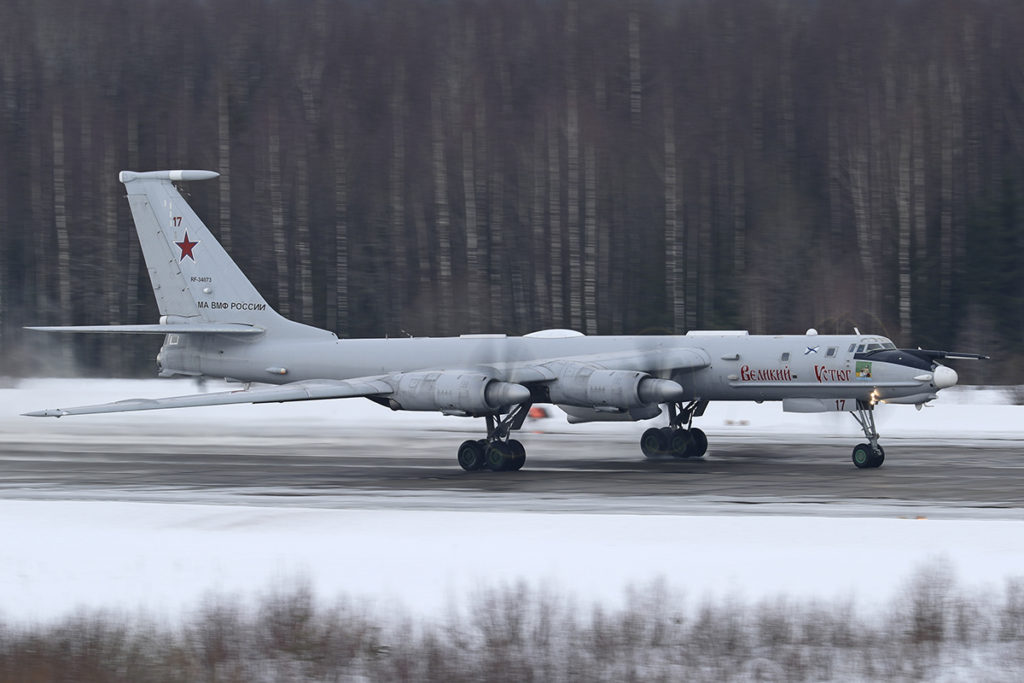
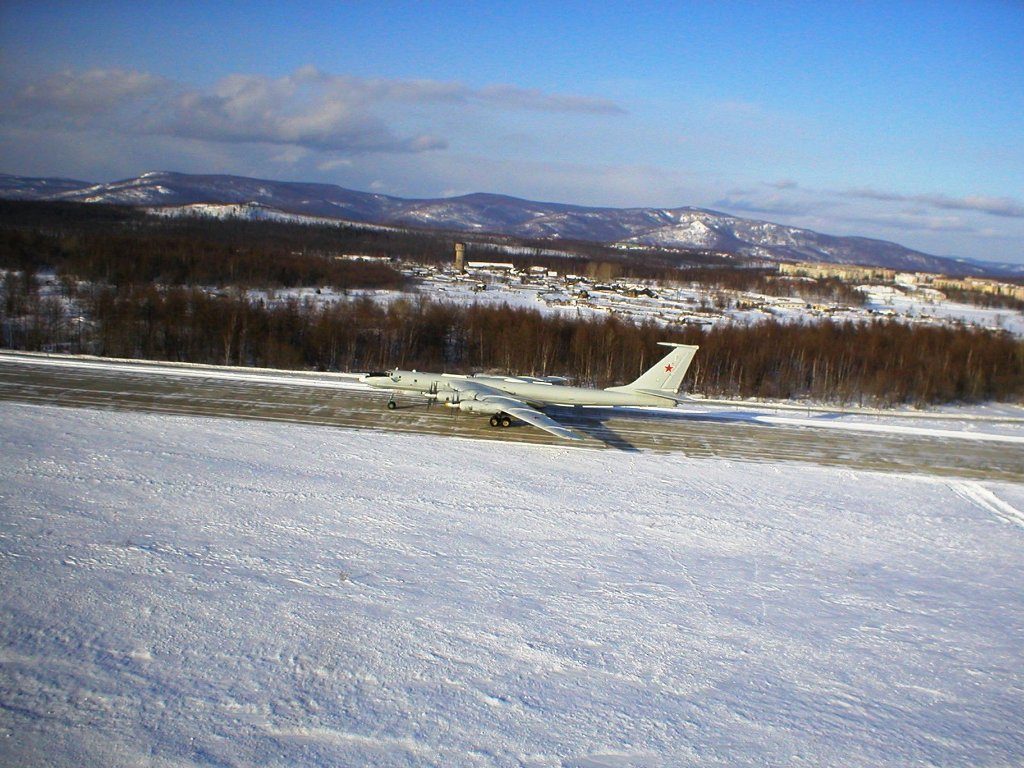
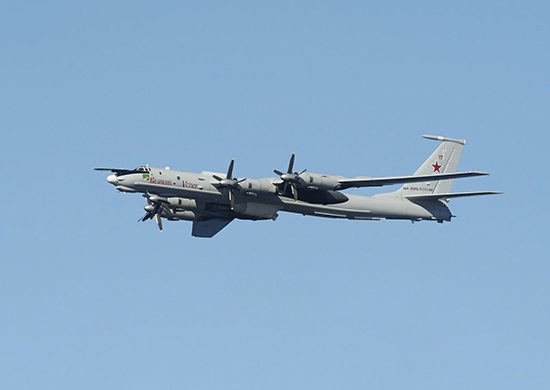
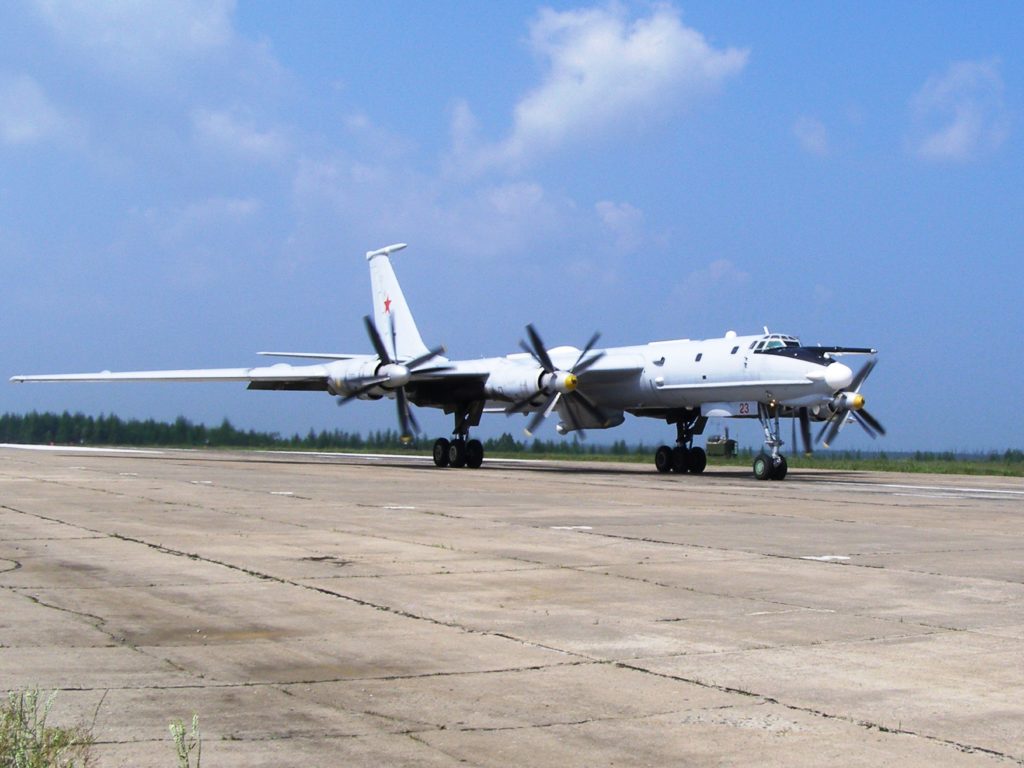


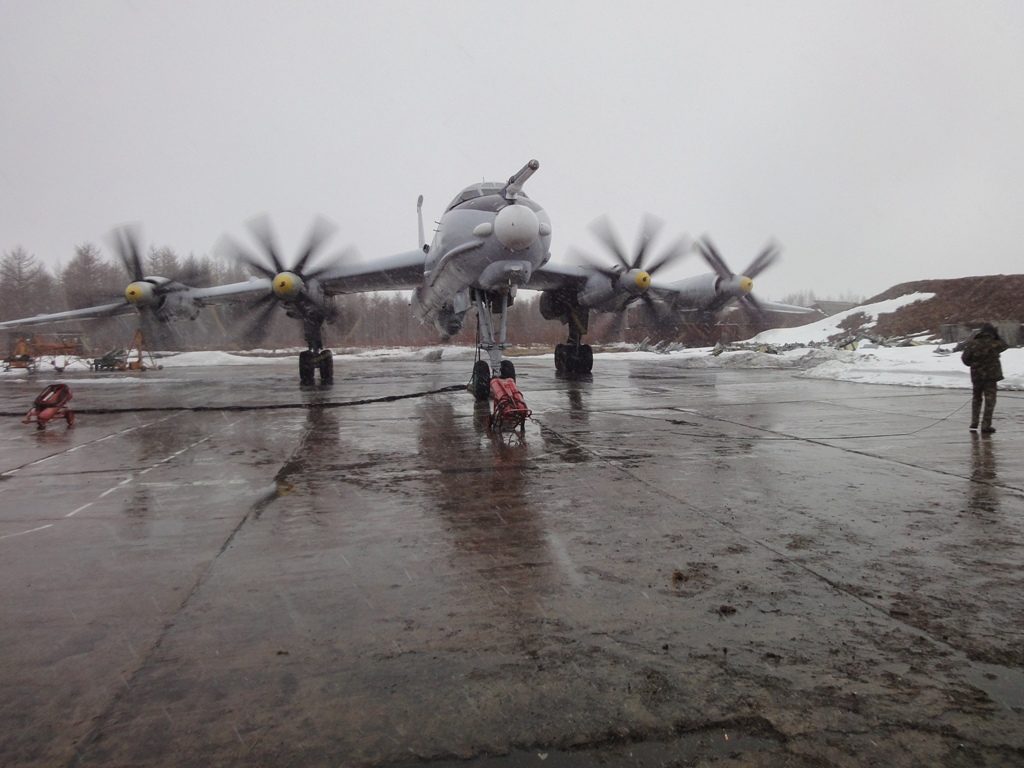
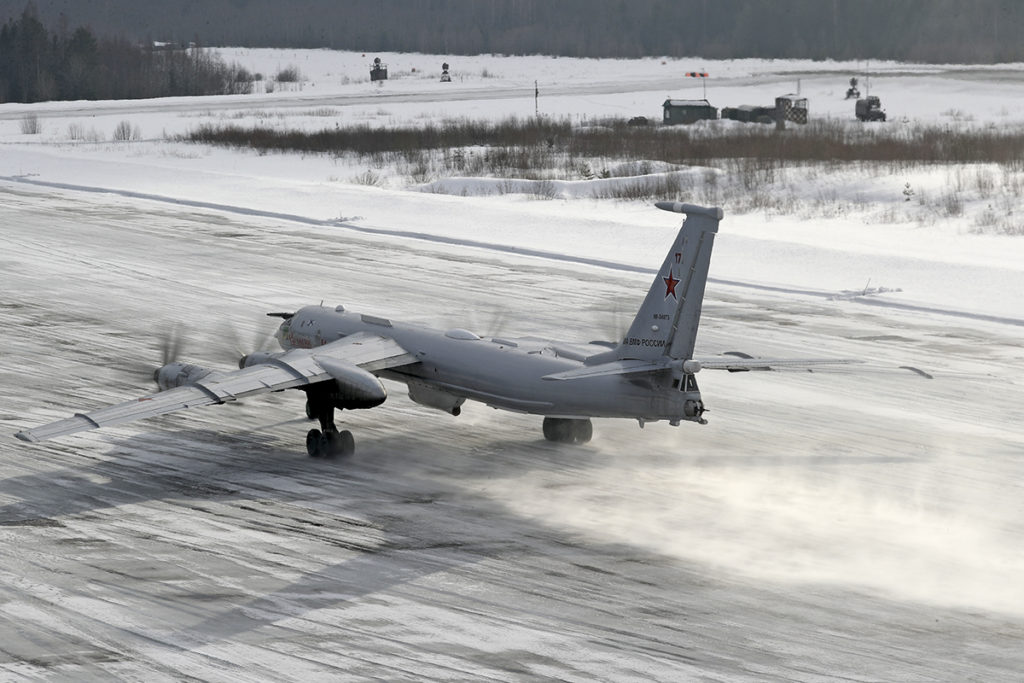
Thanks Mr. Dent. gives me a better view of recent intercept reports and what’s up (and down – under).
I’m a 1970’s vintage e-engineer somewhat on the outside looking in, heading stories from x-colleagues. Thanks for the detailed view, regards,
Mike, You are welcome. During the Cold War, there were a few of these planes but they had a very special and important mission to accomplish. Glad to see that you find it interesting and useful.
Thanks Your So Verry Much Paul Den Review Tupolev Tu 142 MR 1970 1985 Love USSR
Great looking blog! Amazing amount of technical information and illustrations! The Russians will never give up those tail-guns; putting them on every large aircraft and even the (WIG) Ekranoplan! Always fun to imagine a fishing boat far at sea, being confronted by a big cable wooshing about- seeming to come from nowhere out of the heavens.
Thank you. This is a great read for fans of Russian aircraft and I enjoyed it a great deal.
Great article, Paul. I’m about to build a 1/144 scale model of this aircraft and your detailed explanation of many features, plus pics, will be very useful!
Like a couple of the commentators above, I grew up in the 50’s-60’s with the constant fear that the “cold war” could suddenly turn hot and have always had a keen interest in military aviation. Your website is a welcome addition to my references.
Thanks again, Richard
Thank you Sir. As former NAVAIRINTL the article helped explain past experiences and understand current intercepts.